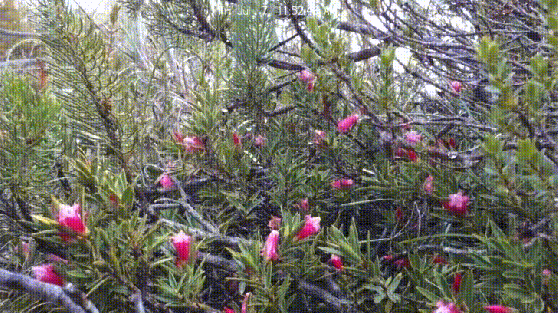I’m thrilled to share this never-before seen sequence of birds feeding on Astroloma stomarrhena, a winter-flowering shrub endemic to Western Australia.
Earlier this year, I decided A. stomarrhena looked like a perfect candidate for my new study on pollinators and gene flow. What I needed was a bird-pollinated species of plant, closely related to an insect-pollinated species. This one seemed to match all the criteria I needed, except there was no evidence that it was bird-pollinated. But with those long, tapered corolla tubes, and that pink-red coloration, I believed that birds absolutely had to be the pollinator.
The danger was, that while birds might be visitors, the plant could be somewhat “generalized”, and also use insects. This is pretty common, especially in places like Australia where European Honeybees (Apis mellifera) have invaded ecosystems that evolved in their absence, and honeybees will visit absolutely everything whether the plants are adapted to bees or not.
By deploying a new camera-trapping method that I am developing to record insect visitation, I was able to gather several days of pollinator observations, despite some very bad weather. After initially being baffled as to what honeyeater might visit such a low ground-hugging shrub, I got my answer after day one, when I captured video of my new favourite bird: the Tawny-crowned Honeyeater (Gliciphila melanops) feeding on the flowers. Furthermore, the recordings of honeybee fly-bys are sufficient to rule them out as pollinators.
This little result is a win on two fronts: a successful trial of new pollinator-monitoring cameras, and vindication of predicting pollinators from flower morphology.
Click here for the full HD video.

